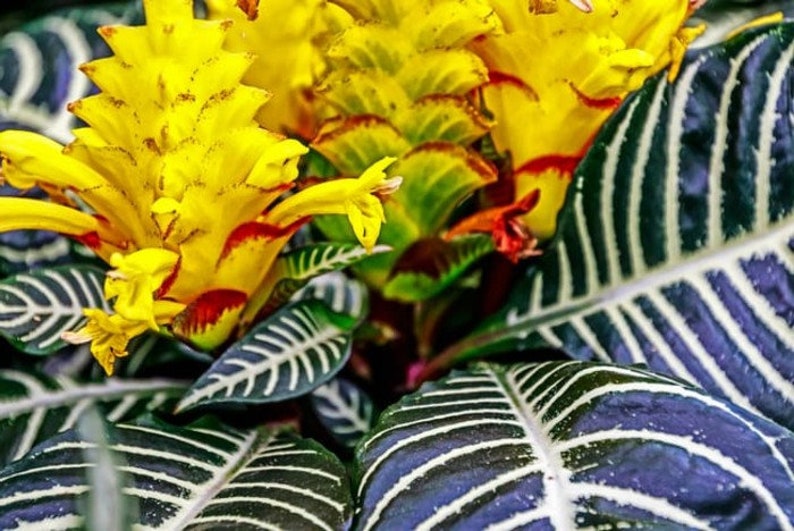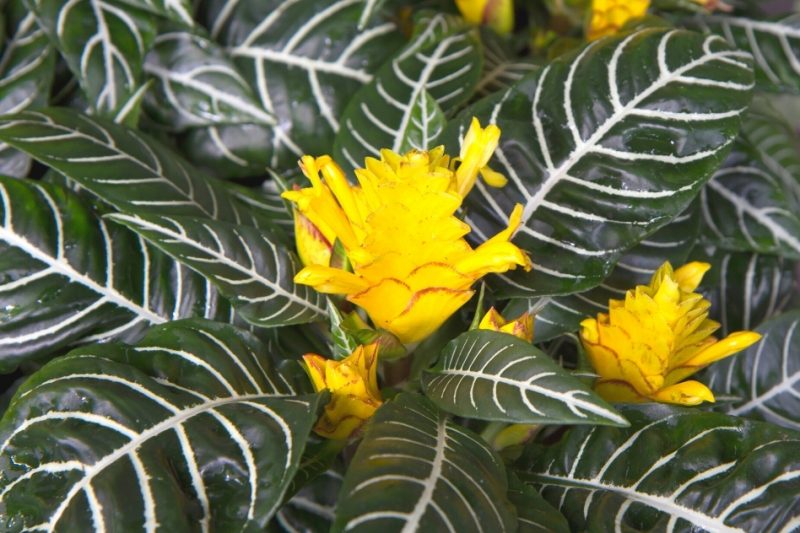This beautiful plant boasts flowers that demand attention but most people are attracted by its unusual foliage. Its large leaves and dark colors are features that have led to the nickname Zebra Plant. The Aphelandra Squarrosa is a great addition to any home and can add a unique aesthetic.
However, the Zebra Plant is quite difficult to grow and demands attention to detail. It can die quite easily if its needs are not met. But once you understand this plant’s needs and get its care on a schedule, you’ll discover that it’s relatively low maintenance. It’s just that you have to do everything right.
Due to the difficulty in maintaining this plant, it’s not recommended for those new to gardening. The Aphelandra Squarrosa is not the only plant that uses the nickname “Zebra Plant” so it gets a bit confusing.
Watering the Aphelandra Squarrosa White Wash
Watering the Aphelandra Squarrosa is the most difficult task w caring for this plant. Once you master this important step, you’ll be able to keep this beautiful plant alive.
First and foremost, it reacts poorly to being overwatered and under watered so you have to find the right balance. What makes this even worse is that there is a small margin of error here. If that’s not complex enough, the level of water that this plant needs is different depending on the time of year.
During the summer, it requires just enough water to keep the soil moist but not so much that it’s soggy. I know that you’re probably thinking that this requires you to water in tiny increments more often, but that’s not the case. It’s actually better to heavily water the plant every month so that all of the soil is reached.
It should be watered once per month. Add the water slowly and wait a moment for the soil to take it in. Repeat this until water seeps from the bottom of the container. Immediately discard any water that drains out.
During the month, check the soil weekly to make sure it doesn’t dry out. Depending on your home and the environment where you live, you might have to water it more than once a month. If the top layer of soil gets dry, water the plant.
Watering the Zebra Plant during winter follows the same process but you won’t have to water it as often. It’s okay to let the top few layers of soil dry before watering during the winter.
Soil and Potting Guide of Zebra Plant
The Aphelandra Squarrosa loves soil that’s slightly acidic in nature so I highly recommend you make a special mix for this picky plant. Simply use this combination:
- 1 Part of Builders Sand
- 1 Part of Garden Soil
- 2 Parts Peat
The acidity of soul must be maintained anywhere between 5.5 and 6.5, otherwise the plant will rebel against you. Testing strips are highly recommended.
Don’t rush to repot the Aphelandra Squarrosa though. Again, it’s quite fussy and doesn’t like to be moved so only do it once every two to three years. Use a pot that is one-inch larger than the last and be sure you clean all old soil away from the plant’s roots. Fill the new pot with one layer of soil and then place the plant on top of it before filling in the rest of the pot.

Temperature
Room temperature is within the ideal range for the Aphelandra Squarrosa, which is anywhere from 65 to 80 degrees. Just keep this in mind if you go on vacation or have the plant outdoors. Also be sure that you keep the plant away from heating and cooling vents because they can easily cause problems.
It’s also important to keep this plant’s temperature from fluctuating. Even if the change stays within the ideal range, this plant will struggle if the temperature changes rapidly. It’s a highly temperamental plant!
Light Guide for the Aphelandra Squarrosa
Lighting depends on whether or not you want to bloom its flowers. If you are only interested in the unique foliage, then it needs less light so you can place it on a darker side of the room.
However, if you want the plant’s flowers to bloom, then it must have access to a lot of light. But this plant is quite tricky so you have to make sure it gets a good balance of direct sunlight, indirect sunlight, and shade. Since it’s native to the rainforest, the Aphelandra Squarrosa thrives from indirect sunlight. Too much direct sunlight will damage it.
Consider placing it close to a window that only gets an hour of direct sunlight. That way, its exposure is limited but it still benefits from the brightness of sunlight coming through the window.
Environmental Requirements for the Aphelandra Squarrosa
Since the Aphelandra Squarrosa is native to rainforests, it requires high humidity in order to thrive. The problem is that high humidity isn’t found in most homes. Therefore, you’ll have to create this humidity.
Don’t worry though because it’s easy. Use a spray bottle to lightly mist the plant with water. But only do it at a time of day when you know the water will evaporate quickly. This touchy plant hates water on its leaves.
Another method that’s often used for the Aphelandra Squarrosa is to have an additional tray with pebbles. Add water to the tray and have the plant sitting on top of that tray to simulate humidity. Just be sure to keep water in this tray.
Proper Fertilization Tips
In comparison to most other house plants, the Aphelandra Squarrosa needs to be fed quite often. Use a balanced food that will target both the foliage and flowers for the best result. Also fast-released food is the best choice for the Aphelandra Squarrosa.
Always follow the instructions that come with the fertilizer for best results. Finally, never feed the Aphelandra Squarrosa during winter.

Propagation Facts
Propagation of the Aphelandra Squarrosa is surprisingly easy given the temperamental nature of this plant. Here’s the propagation process:
- Remove a cutting from the plant. It must be between 4 to 6 inches.
- Remove lower leaves from the cutting.
- Dip the bottom end (raw end) of the cutting in rooting hormone.
- Fill the new pot with soil. Water it until it’s moist.
- Make a small hole in the soil and press the cutting into this hole. Press soil to support the cutting.
This cutting must be kept in a warm and humid environment. You can cover the cutting with plastic to force humidity. It will take it approximately a month to form roots. New leaf growths show you that the roots have taken hold.
Pest Control Tips
There are three main types of pests that you’ll need to watch out for with the Aphelandra Squarrosa:
- Whiteflies: Identified by yellow dots on the leaves. Remove leaves and use an insecticidal soap to combat.
- Mealybugs: Similar to whiteflies and can be prevented by lightly misting leaves with a special oil.
- Aphididae: These also attack leaves and are treated using insecticidal soap.
Final Thoughts
Follow this Aphelandra Squarrosa White Wash (Zebra Plant) care guide if you’re taking on the challenging endeavor of caring for this plant. Just keep in mind that it’s much fussier than the average houseplant and requires a much stricter routine.






Leave a reply